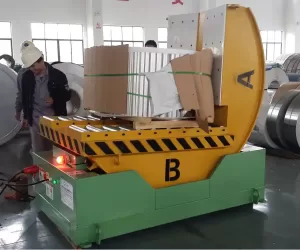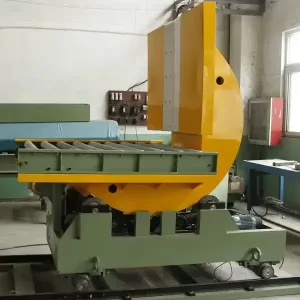Mastering Heavy Load Rotation: Understanding Upenders and Tilters in Modern Fabrication
Handling large, heavy, and often cumbersome materials like metal coils, large molds, or heavy dies presents significant challenges in industrial settings. Safely and efficiently rotating these items through 90 degrees for processing, inspection, storage, or transport is critical. This is where specialized material handling equipment like mechanical upenders and tilters become indispensable tools.
What are Upenders and Tilters?
Often referred to as coil positioners, load tilters, or 90-degree tilters, mechanical upenders are robust machines designed specifically to rotate heavy loads safely and precisely. Their primary function is to take an object lying on one plane (e.g., a coil stored eye-to-the-sky) and tilt it 90 degrees to another orientation (e.g., eye-to-the-horizon for processing).
These machines typically utilize a powerful drive system, often involving electric motors coupled with heavy-duty chains or hydraulic mechanisms, to ensure smooth and controlled rotation of loads that can range from a few tons to upwards of 200 tons, depending on the design and application.

Key Applications in Industry
Upenders and tilters find wide application across various heavy industries:
- Metal Coil Handling: Positioning steel or aluminum coils for slitting, stamping, or uncoiling lines. Proper orientation is crucial for feeding processing machinery.
- Die and Mold Handling: Safely rotating heavy dies and molds for maintenance, storage, or positioning within stamping presses or injection molding machines. This significantly improves safety compared to manual or crane-based flipping methods.
- Engine Block Fabrication: Positioning large engine blocks or components for machining or assembly operations.
- Paper Roll Handling: Tilting large paper rolls for printing presses or converting lines.
- Palletizing and Depalletizing: Orienting large or unstable loads for secure palletizing or easier access.
- Assembly Operations: Positioning heavy sub-assemblies for easier access during the manufacturing process.
Core Features and Design Considerations
When evaluating or specifying an upender or tilter, several key features and design aspects are crucial:
Heavy-Duty Construction
Given the substantial weights involved, these machines are built with exceptionally sturdy frames and platforms, often using heavy-gauge steel fabrications. Robust construction ensures longevity, reliability, and safe operation under demanding industrial conditions.
Precise Positioning and Control
Modern upenders often incorporate advanced control systems (like PLCs) allowing for programmed rotation cycles, controlled acceleration/deceleration, and precise stopping at the desired 90-degree angle. This precision is vital for integrating with automated lines and preventing load damage.
Drive Mechanism
Mechanical upenders commonly rely on electric motors driving single or double roller chains connected to the rotating platform. Hydraulic systems are also used, particularly for very high capacities or specific control requirements. The choice depends on factors like capacity, speed, duty cycle, and environmental conditions.
Load Capacity and Size Accommodation
Units are designed for specific maximum load weights and dimensions. Many systems offer adjustable features or are custom-engineered to accommodate a specific range of coil diameters, mold sizes, or other workpiece dimensions.
Safety Features
Safety is paramount. Standard safety features often include:
- Limit Switches: To prevent over-travel.
- Emergency Stops: Easily accessible buttons to halt operation instantly.
- Weight and Position Sensors: To ensure the load is correctly positioned and within capacity limits.
- Physical Guarding: Barriers or light curtains to prevent personnel from entering the operational zone.
- Load Securing Mechanisms: Clamps or fixtures may be integrated, especially for irregularly shaped loads.
User-Friendly Operation
Despite their complexity, operation is often simplified through intuitive controls, such as touchscreen interfaces (HMIs). These allow operators to easily initiate cycles, monitor status, and perform basic troubleshooting. Maintenance access points are also considered in the design.
Versatility and Customization
While standard configurations exist, many applications require customization. This might involve specific platform sizes, unique load supports, integration with conveyors, specialized control sequences, or environmental modifications (e.g., for outdoor use or cleanroom environments).
Benefits of Using Upenders and Tilters

Integrating upenders and tilters into a material handling process offers significant advantages:
- Enhanced Safety: Dramatically reduces the risks associated with manually handling or improperly rotating heavy, unstable loads, minimizing potential crush injuries or accidents.
- Increased Efficiency: Speeds up the process of load reorientation compared to using cranes and slings, leading to improved throughput.
- Reduced Product Damage: Controlled, smooth rotation prevents damage to sensitive materials like metal coils (edge damage) or intricate molds.
- Improved Ergonomics: Eliminates strenuous manual tasks, reducing worker fatigue and potential musculoskeletal injuries.
- Optimized Floor Space: Can facilitate more efficient plant layouts by streamlining material flow.
Conclusion
Mechanical upenders and tilters are essential equipment in modern fabrication and heavy manufacturing environments. By providing a safe, efficient, and controlled method for rotating heavy loads like coils, dies, and molds, they play a vital role in enhancing operational safety, boosting productivity, and protecting valuable assets. Understanding their function, features, and benefits is key to optimizing material handling processes in demanding industrial settings.